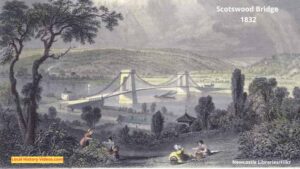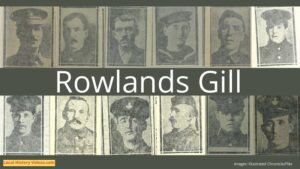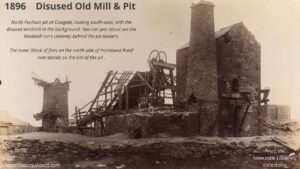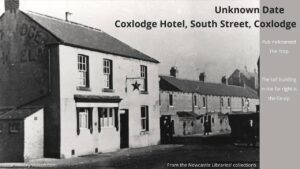Glimpse history through old images of Whickham, in Gateshead, North East England.
In 1183, the Boldon Book was compiled for the bishop of Durham, surverying the region’s property and estates, and this is where we find the first known mention of Whickham.
St Mary’s Church
The existence of Whickham’s church, churchyard and vicar were recorded back in 1220.
But the nave dates back to the Norman period, the chancel was built in the 12th century, and the porch and bell tower were added in the 14th century.
Unfortunately, the church suffered great damage in a fire in 1841, which nearly destroyed it, and much restoration work followed.
In the churchyard are a number of interesting graves and memorials, including
- 1626 memorial to children who died of the plague
- 1769, a lady who died at the age of 102
- Harry Clasper, the celebrated Victorian rower
- William Shield, who composed the Auld Lang Syne tune
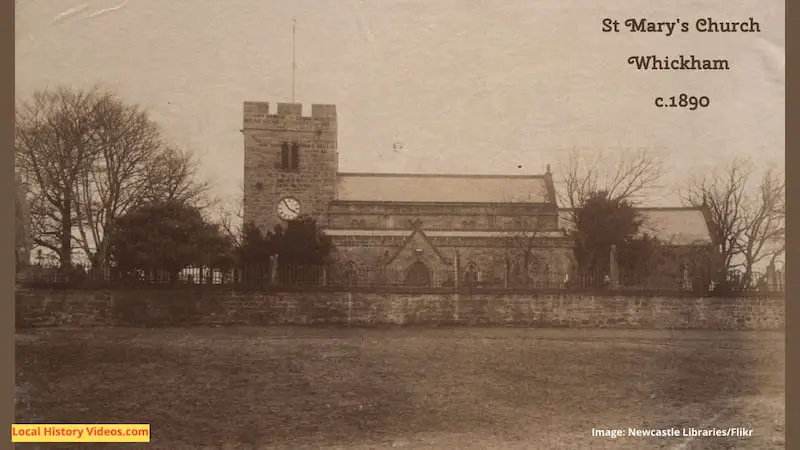
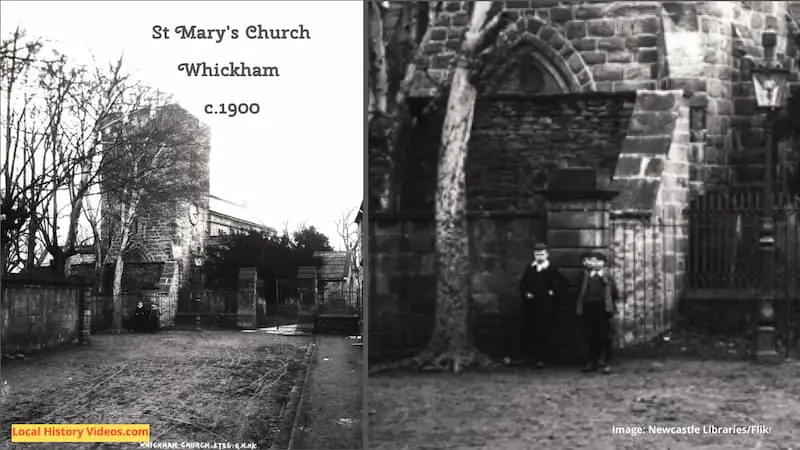
Whickham Village
This first photo shows a lot of detail so I’ve added two closeups. There are signs some horses had recently travelled along the road!
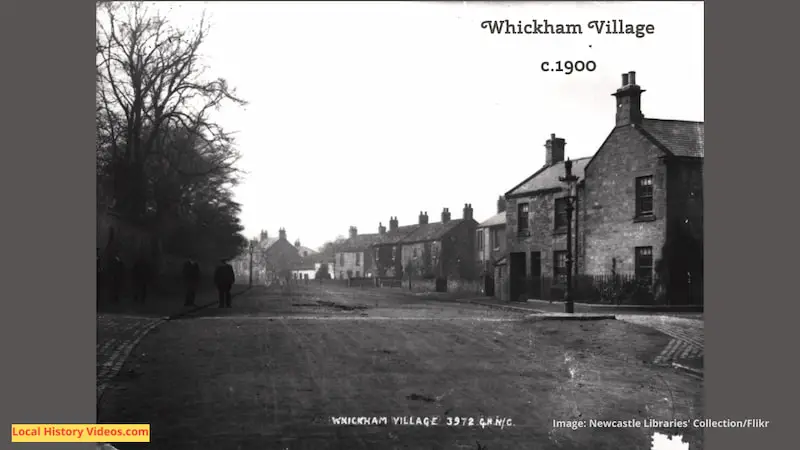
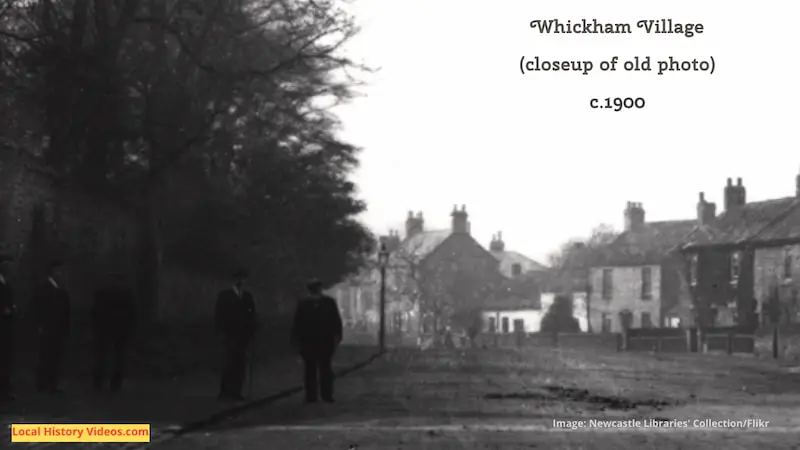
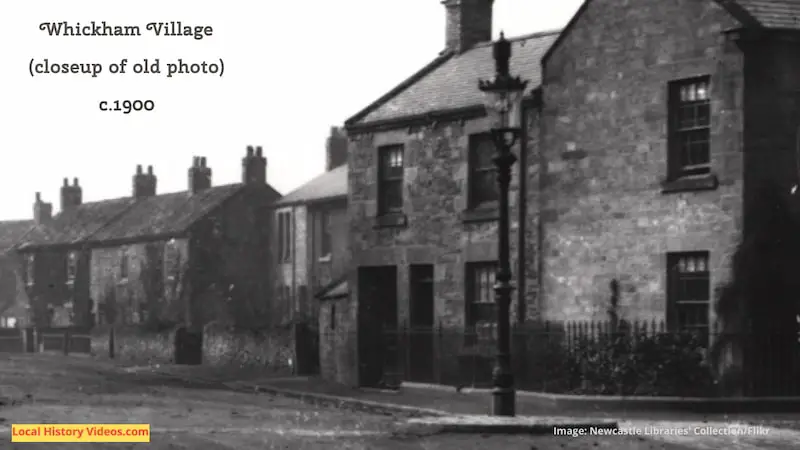
The workman to the left seems to be doing some work on the edge of the road. I’ve added a closeup of the centre of the image, for a clearer view of the houses.
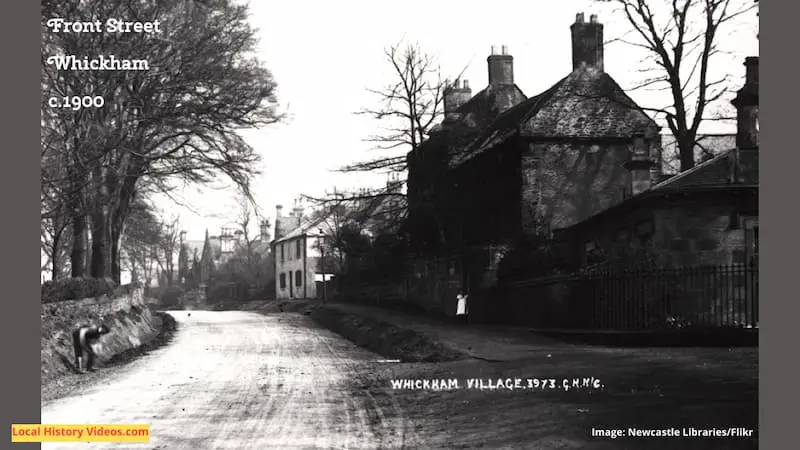
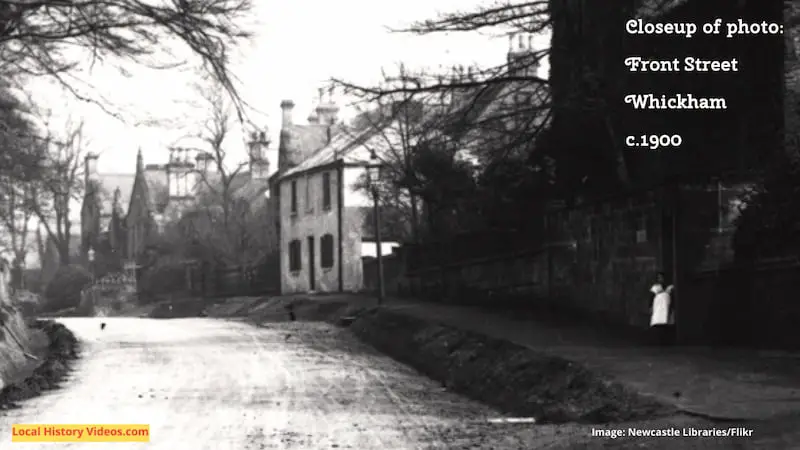
The house to the right has fancy lights and metalwork outside it. I’ve added a closeup, so you can see a bit more of the buildings further away, but they are unfortunately obscured by the greenery which makes this such a pleasant road.
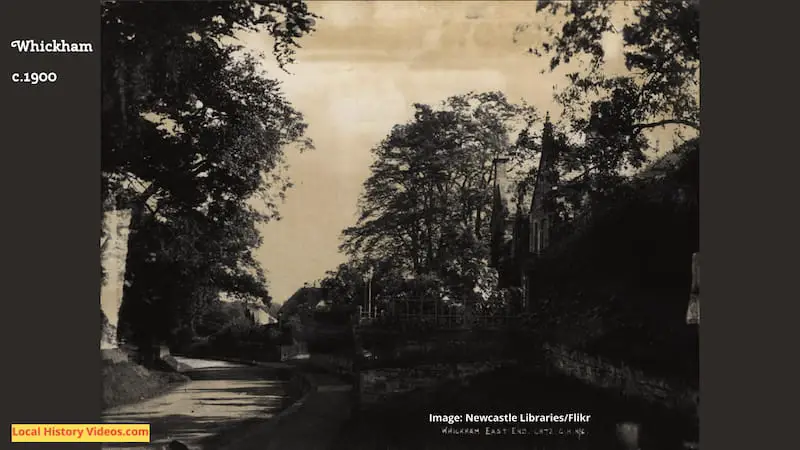
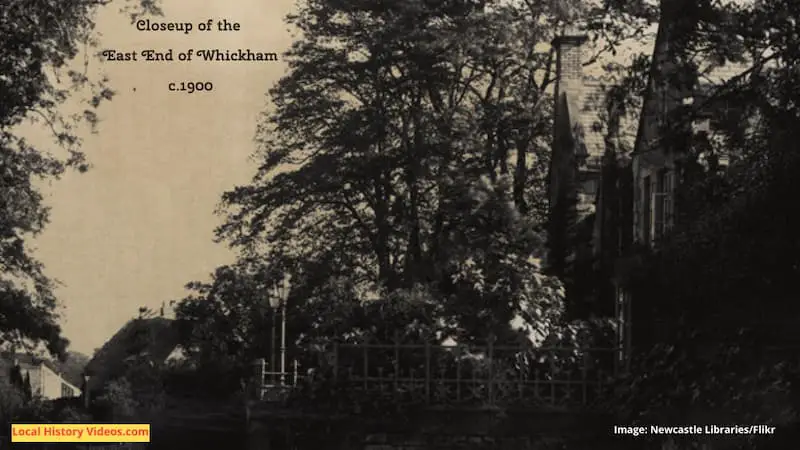
Water pumps were an essential part of village life before all houses had running water.
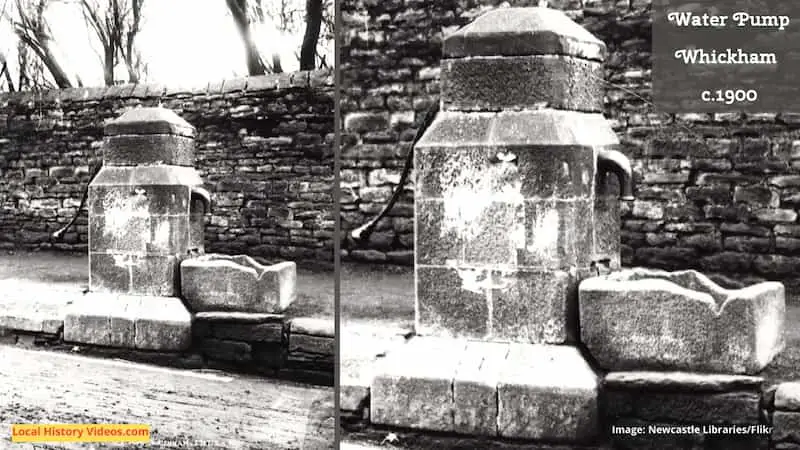
Coming back to the same part of Front Street seen in the photo of the child and workman above, little has changed although the white house now seems to be a stone colour. Is it possible the dates in the archives are wrong?
I’ve added a closeup so you can see a woman standing in the doorway of the house which was white in the other photo. There are also a couple of women in long skirts chatting together further along the pavement.
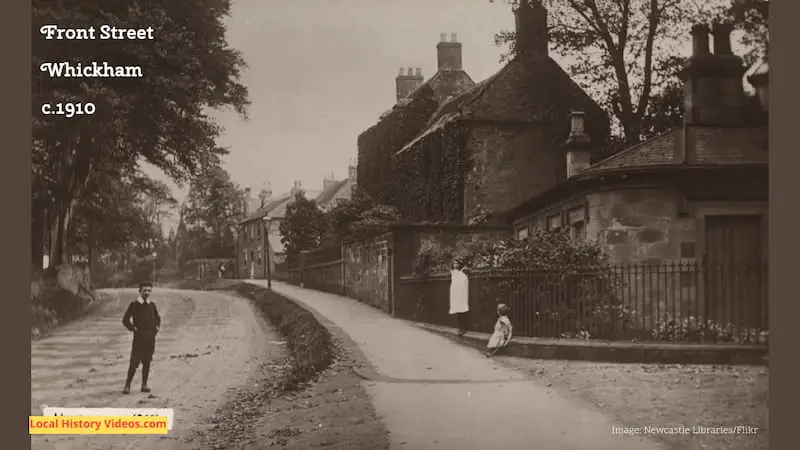
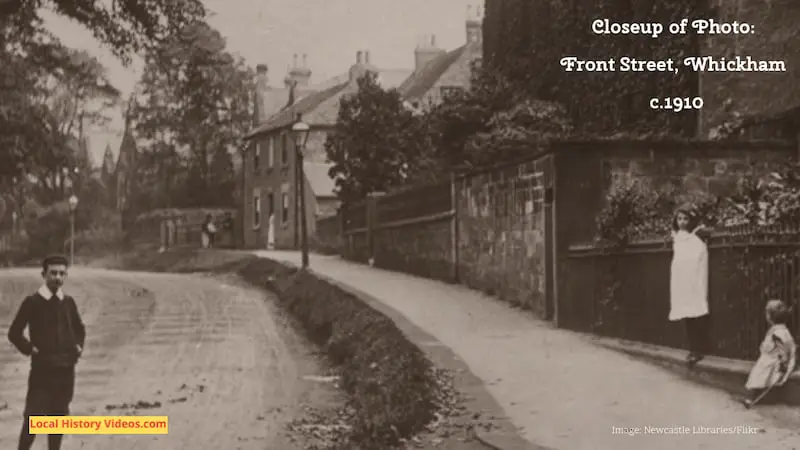
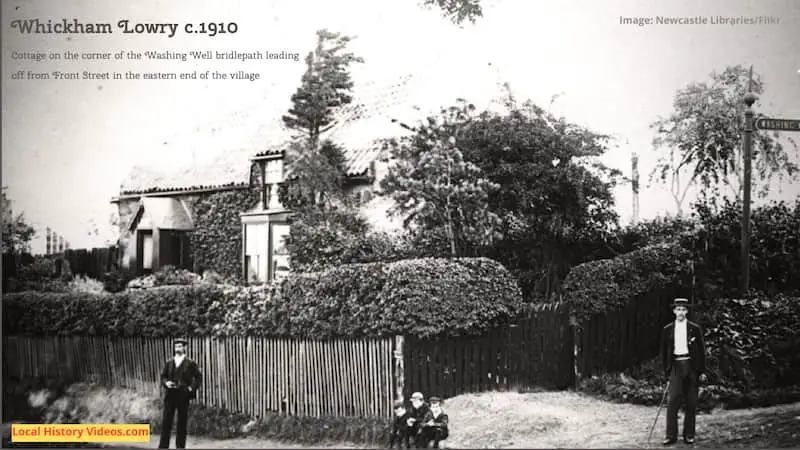
Snow 1979
This home video was made by a teenager on a super 8 film camera borrowed from school. It records the heavy snow of 1979, which was enjoyed by many.
After a minute showing the residential road, there’s a brilliant pan across the modern shops on Front Street, zooming in to the Frozen Food Centre.
Then there’s a glimpse of the junction where Whickham Bank, Front Street, and Fellside Road meet, and then images of several nearby streets.
Whickham snowed in, 1979 (archive amateur film) – GoFindChannel on YouTube
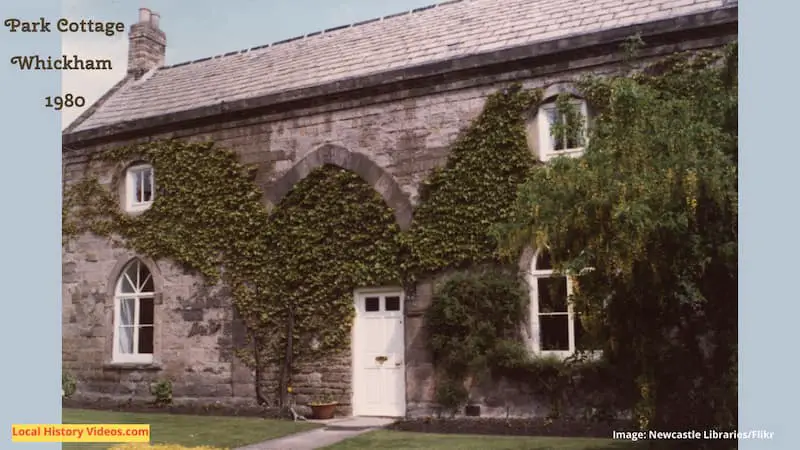
Historic Book
Extracts from:
“The History and Antiquities of the County Palatine of Durham: Municipal Divisions; Its Agriculture, Mineral Products, Manufactures, Shipping, Docks, Railways, and General Commerce; Its Public Buildings, Churches, Chapels, Parochial Registers, Landed Gentry, Heraldic Visitations, Local Biography, Schools, Charities, Sanitary Reports, Population, &c · Part 2″
By William Fordyce
Published in 1857.
Page 687
Whickham is a large and respectable village , 4 miles west-south-west of Gateshead, on the turnpike road from that town to Shotley Bridge. It occupies the high brow of a steep hill , which overlooks the pleasant vales of Tyne and Team, and commands an extensive view of Newcastle, and the high grounds on the north side of the Tyne. Many of the houses are modern and handsome, and the smaller tenements have generally an air of cleanliness and comfort.
The village contains a library and reading room, three farmsteads, four public gardens, five inns and public houses, a beer-shop, a post office, two surgeons, several shopkeepers, with various mechanics and workmen. There are two respectable boarding schools for young ladies, carried on by Miss Simons and Mrs. Harding.
The mansion at the east end of the village, formerly occupied by Charles Attwood, Esq., is now the residence of J.A. Hymers, Esq. The pleasant and well-sheltered mansion of the Williamsons , Whickham Lodge, is on the south, and is now occupied by Edward Richardson, Esq. Whickham Hall, also the property of the Williamsons, is the residence of Mr. J. H. Stevenson, surgeon. Whickham House is the property of G. T. L. Blenkinsopp , Esq., of Hoppyland, The Wesleyan and Primitive Methodists have each a chapel in the village. The Whickham band consists of the musicians of the place.
Pages 688 and 689
By Boldon Book , there were 35 villains in Whickham, each of whom held an oxgang of 15 acres, at 16d. rent, exclusive of services, which were severe.
Each villain wrought for the lord three days in every week in the
year, besides the labour of harvest and ploughing; they were bound to erect a cottage 40 feet long, and 15 wide, every year, for the maintenance of the town; and to carry and fetch from Durham and Bedlington the bishop’s baggage when required, with the allowance of
the corrody whilst they wrought.
They also paid 9s cornage rent , and provided a milch cow for the lord; and for every oxgang of land they found a hen and ten eggs, and served in the lord’s fishery in Tyne.
The præpositus, or head-borough man, now called the grieve, had 24 acres of land allotted to him in recompence for the duties of his office.
The manor was under farm with the villain service, mills, carts, harrows, fisheries, and 20 chalders of oats of the bishop’s measure, rendering 271, and performing certain services in carriage, for which there was an allowance of 2d. for every horse.
The punder had land assigned him, besides an acknowledgment from every tillage farm by the thrave; and he provided the bishop with 40 hens and 300 eggs.
In Bishop Bury’s time, Robert Bridock and William Herring occur as tenants.
The tenures and services are detailed at great lengthin Hatfield’s Survey, at which period the services were being commuted into monied rents, and the whole gradually assuming the appearance of a leasehold manor. It is still held as such under the see of Durham. Swalwell, Axwell, Hollinside, and Fugerhouse, had become free estates, held by reserved rents under the see, previous to Hatfield’s Survey.
Two persons from Whyckham, who joined the Northern Rebellion in 1569, were executed.
Near Whickham is a stratum of burnt earth, consisting chiefly of clay and stone, which tradition says was caused by the English army setting fire to their tents previous to their hasty retreat, when the Scots forced the passage of the Tyne in 1640. The burning camp communicated with a seam of coal, which is said to have burnt for many years with great fury; and the culcined stones and earth are now made useful and ornamental in forming garden walks and paths to gentlemen’s houses.
Cromwell’s army, or some considerable portion of it, lay at Whickham on their march to Scotland in 1648.
The north common fields of Whickham were divided, by agreement of the various parties interested (about 30 in number), April 16, 1672. This division was confirmed by decree in the bishop’s Court of Chancery. An injunction was also issued, under which the highways were set out, and ordered to be repaired by the parishioners.
An act of parliament (51 Geo. III ., c. 21), for enclosing lands in this parish, was passed April 4, 1811. The preamble recited that Whickham Fell contained about 500 acres; the bishop being lord of the manor, and Sir Thomas – Henry Liddell, Bart., James – Archibald – Stewart Wortley , Esq., and the Right Hen. John Bowes, Earl of Strathmore, being lessees of the said manor. The parties claiming right of common were, the Earl of Strathmore, Sir T. H. Liddell, the Marquises of Bute and Hertford, John Carr, Robert Hopper Williamson, George Thomas Leaton, and Jasper Harrison, Esqrs., and others. Mr. John Bell, of Newcastle, was appointed
sole commissioner for carrying the act into effect.
An allotment was to be made and inclosed for the rector of Whickham, in respect of his glebe; and one – sixteenth of the common was to be appropriated to the bishop as lord of the manor, to whom the usual reservation was made of the mines, with the power of working them, in doing which as little damage as might be was to be done to the proprietor of the soil, and for which reason able satisfaction was to be made. Mr. Bell’s award was read December 18, 1821.
MINES
Bishop Bury granted a lease of the mines under the manors of Whickham and Gateshead to Sir Thomas Grey, Knt., and John Pulhore, rector of Whickham, for twelve years, under 500 marks rent. The lease was renewed to the same parties by Bishop Hatfield, at Martinmas, 1356; and the same prelate appointed Nicholas Cole, of Newcastle, Keeper and Vender of his coals, within the two manors, on July 24, 1367.
Bishop Tunstal, July 24, 1550, demised to John and Stephen Sotheran (who had purchased the remaining interest in a lease for 21 years), with a condition for payment of 10 l on opening every new pit.
On May 20, 1570, Bishop Pilkington leased to Bartram Anderson, of Newcastle, merchant adventurer, the coal-mines within the Cross Moor in Whickham, adjoining the Whagges and Newfield on the north, Gellesfield and Greenleyfield south, the Cross Moor west, and the road from Newcastle to the Streat yate east; three pits only to be opened at once, 21 years, 30 l rent.
Amongst the possessions of the see extorted from Bishop Barnes by Queen Elizabeth in 1582, were the manors of Whickham and Gateshead.
On November 12, 1583, the lease of 99 years was transferred by the crown to Henry Anderson and William Selby, aldermen of Newcastle, who, in 1591, granted to thirteen principal burgesses, on trust for the corporation of that town, who held the “grand lease” till its expiration in 1681.
The reversion had been granted by Bishop Cosin to his son-in-law, Sir Gilbert Gerard, and others.
Bishop Crewe afterwards leased to Colonel Liddell and his partners; and the manor of Whickham has since been held by their successors, Lord Ravensworth and Partners, popularly called the Grand Allies.
CHARITIES
Charities of Blackiston and Thomlinson . – Whickham parochial school was originally founded by Dr. Thomlinson, about the year 1714, who applied to this purpose a legacy of 100 l , left by Jane Blackiston, for teaching poor children of the parish in the Church Catechism and
reading and writing, and for putting them out to trade; and who also himself, by his will, dated November 18, 1745, left the school and dwelling-house for the master, with certain galleries and pews in the church, and the sum of 100 l in addition to the like sum given by Mrs. Blackiston, to the archdeacon of Northumberland, the vicar of Newcastle, and the librarian of the testator’s library at Newcastle, and their respective successors, for the support of such school.
The 200 l. was laid out, in 1751, in the purchase of 200 l. South Sea Annuities, now producing 6 % a year; and an allotment of three-quarters of an acre of land, set out to the school, is let for 14. per annum.
The rents of the pews and galleries, formerly amounting to 11 l. or 12 l. per annum, are now merely nominal.
In the year 1825, the school was enlarged by Archdeacon Bowyer, and a house for the mistress erected by private subscription; the national system being adopted at the same time.
The Hon. and Rev. E. Grey was a benefactor, and enabled the institution to extend the means of education to about 160 children, of whom two boys and two girls are annually clothed, or, in the case of the boys, 20s . is given in lieu of clothing.
Harett’s Charity. The sum of 100 l, bequeathed to the parish of Whickham by John Hewett, who died December 3, 1738, is now in the hands of Lord Ravensworth, by whom interest is paid at the rate of 4 1/2 per cent. Agreeably to Hewett’s will, 30s. is laid out annually in Bibles, Prayer Books, and other books of religious instruction; and 20s. is occasionally laid out in clothing for apprentices who have been bound out. A balance is generally kept in the Newcastle savings bank.
Marshall’s Charity. – Robert Marshall bequeathed 20 l to the churchwardens and overseers of Whickham; the interest to be applied towards clothing one of the poorest boys of the charity school. This sum was placed in the hands of Sir Thomas – Henry Liddell, and 14. a year is paid by Lord Ravensworth as interest, which is added
to the produce of Hewett’s charity.
Ralph Harrison, March 26, 1687, amongst his other charitable bequests, left 100 l to the use of the poor of Whickham.
Lady Clavering, May 18. 1726, gave 100 l to the poor of the parish, to which Thomas Bowes, Esq … added 20 l more. The first-named two sums are now in the hands of Lord Ravensworth; but the 20 l is lost. The interest received, 10 l . per annum, is added to the produce of Bishop Wood’s charity, hereafter mentioned; and the whole amount, 18 l. 11s . 3d., is divided amongst the four quarters of the parish, according to the number of applicants in each, and is distributed in the vestry, by the respective churchwardens, on New-year’s Day, in sums of 2s. to each person.
Thomas Wood, Bishop of Litchfield and Coventry, gave 100 l, to the poor of Whickham, and bequeathed, November 11, 1690, a further sum of 100 l . One of these sums was secured on “Jackson’s land,” belonging to Lady Clavering, and produced 64. per annum. The other was placed in the hands of Alderman Fenwick, of Newcastle, who fell into arrears with the interest. He afterwards paid those arrears and 56 l. 10s. of the capital.
The sum of 57 l, was placed in the hands of a predecessor of Lord Ravensworth; and his lordship now pays interest at the rate of 43 per cent., being 21. 11s . 3d . per annum. The agent for the Marquis of Bute’s estates pays the 6 l. from “Jackson’s land;” and the whole is distributed with the produce of other charities, as above described.
Sir James Clavering, by will December 6, 1697, left a rent – charge of 12 l. a year out of his messuage and lands at Crook Bank, out of which he directed that 24 penny loaves of wheaten bread should be given, every Sunday, to as many poor persons of the parish, who shall be present at divine service or sermon; and that 24 coats, petticoats, and waistcoats, of grey russet, should be yearly given to 24 poor men, women, or children, living in the parish, on St. Andrew’s day, such poor persons to be appointed by his heirs. The bread is given to persons named in a list prepared by the churchwardens; and the persons who receive the coats and petticoats are now selected by the rector.
In 1730 , Sir John Clavering, Bart., left 50 l. to the poor of the parish. Nothing is now known of this bequest.
Thomas Borres, in 1721, left land producing 3 l. a year, and 400 l in money, producing 20 l. a year, for clothing and teaching poor children of the parish; and George Bores, in 1739, left land producing 10 l a year for the same purpose. This property became vested in Andrew Robinson Bowes; and no information can now be obtained concerning it.
Samuel Hancock, who died May, 1725 , devised certain lands in Lowfield Bank, parish of Barnard Castle, to trustees, for the use of the poor of Whickham, on condition that his lands in the latter parish should not be charged with poor-money ; but the overseers preferring to assess those lands, the benefaction was given up. The testator also devised lands to the chapelry of Tanfield on the same conditions, which did not take effect for a like reason.
John Bowes, Earl of Strathmore, by his will, dated July 3, 1817, directed that the clear yearly sum of 25 l. should for ever be a charge upon his Gibside estate, and paid to the poor of that estate, in such proportions and manner as the occupier of Gibside mansion – house, or the trustees under his will, should direct. Nothing has hitherto been paid on this account.
The Post Office Directory of Durham and Northumberland
by Kelly and Company
Published in 1879


More about Tyne & Wear
- A Brief History of Scotswood Bridge (With Old Photos & Film)Glimpse history through old images of Scotswood Bridge, which links the West End of Newcastle and the western fringes of Gateshead.
- A Glimpse of History at Rowlands GillA glimpse of history at Rowlands Gill, in North East England.
- Chirton, North East EnglandEnjoy a glimpse of history about Chirton in North Shields, Tyne & Wear, North East England, UK.
- Cowgate, Newcastle Upon Tyne: History in Old ImagesEnjoy a glimpse of history through old images of Cowgate, in Newcastle upon Tyne, Tyne & Wear, England, UK.
- Coxlodge, Newcastle upon TyneEnjoy a glimpse of history about Coxlodge in Newcastle upon Tyne, Tyne & Wear, North East England, UK.
- Dinnington, Newcastle upon TyneEnjoy a glimpse of history about Dinnington in Newcastle upon Tyne, Tyne & Wear, North East England, UK.
- Earsdon, North TynesideEnjoy a glimpse of history about Earsdon in North Tyneside, Tyne & Wear, North East England, UK.
- East Boldon, West Boldon, and Boldon CollieryEnjoy a glimpse of history about the Boldons in South Tyneside, Tyne & Wear, England, UK.
- East Rainton, SunderlandEnjoy a glimpse of history about East Rainton in Sunderland, Tyne & Wear, England, UK.
- Eighton Banks, GatesheadEnjoy a glimpse of history about Eighton Banks in Gateshead, North East England, UK.

